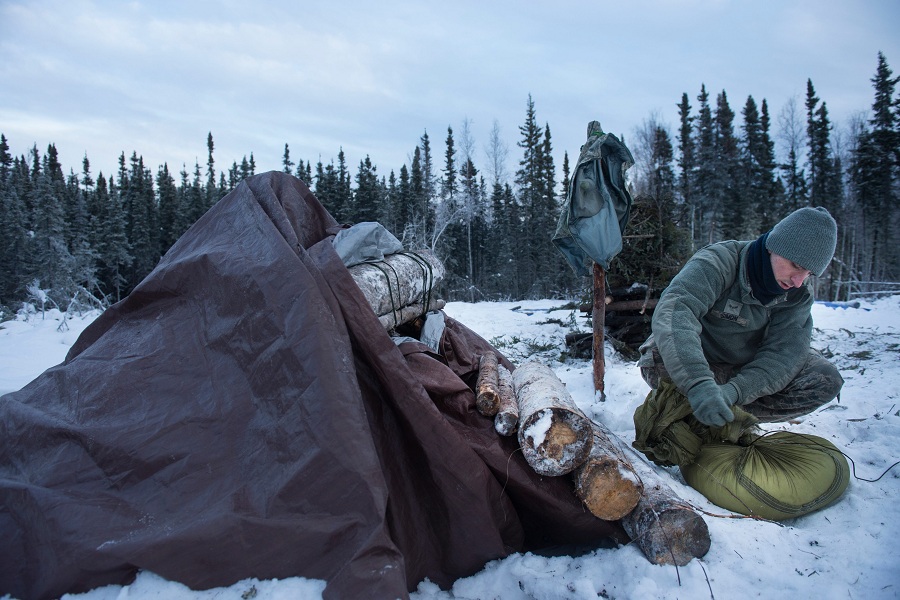Survival in winters is the most frightening thing among the survivors as a bit of mistake can take your life. Survival in different seasons can be easy as nature is not constantly fighting against you.
During winters, you are fighting against nature every moment of the day. Dangers can start anywhere from wild animals to climate adjustment. Read the article to find out winter survival essentials.
Contents
Effect Of Temperature On Your Body During Winters
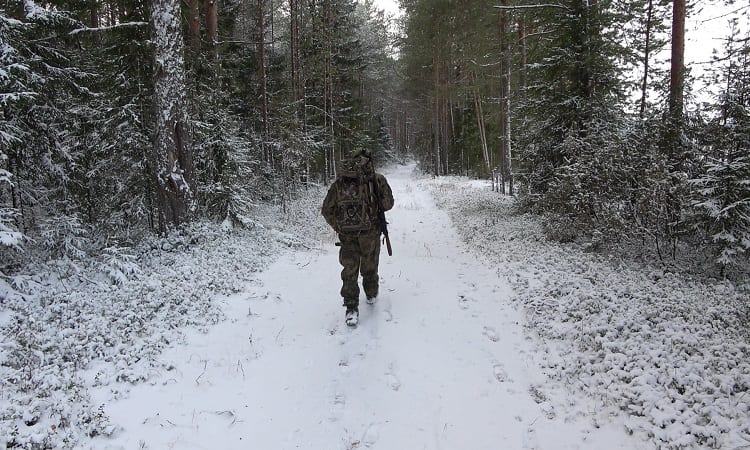
Your body will start showing signs of struggle from the start when the temperature changes and starts dropping. Cold temperature doesn’t mean just feeling cold; it can cause various conditions which might be dangerous.
When the temperature drops, your body needs warmth to keep the body working from the inside to the outside.
When you are unable to provide the heat, your body stops working. The most common and dangerous evil during winters is frostbite and hypothermia.
Frostbite
Frostbite happens when your skin and tissues start freezing because of the low temperature. Frostbite can occur on your toes, ears, fingers, and nose. Frostbite can cause permanent tissue and blood vessel damage if the condition worsens.
Symptoms include tingling and numbing of skin. Discoloration of the skin is another sign you have to look for. Some other symptoms include non-functioning of the part, skin turning black, and the occurrence of blisters.
Hypothermia
Hypothermia occurs when a person’s body temperature drops down and cannot produce heat faster. Hypothermia is a severe condition that you have to pay attention to.
The low body temperature can put your nervous system, heart, and other vital organs in a state of shock, leading to the risk of heart attack, respiratory system failure, and possibly death.
Risks of hypothermia include slurred speech, shivering, lack of coordination, and confusion. To avoid this, you should always strive to keep your body warm and covered.
Your blood should always pump and reach every corner of the body.
Sheltering For Survival
Building a shelter should be your number one priority during winters. Shelters will keep you warm and safe from the temperature, cold winds, and natural elements. Few shelter types that you can rely on:
Tree Pit Snow Shelter
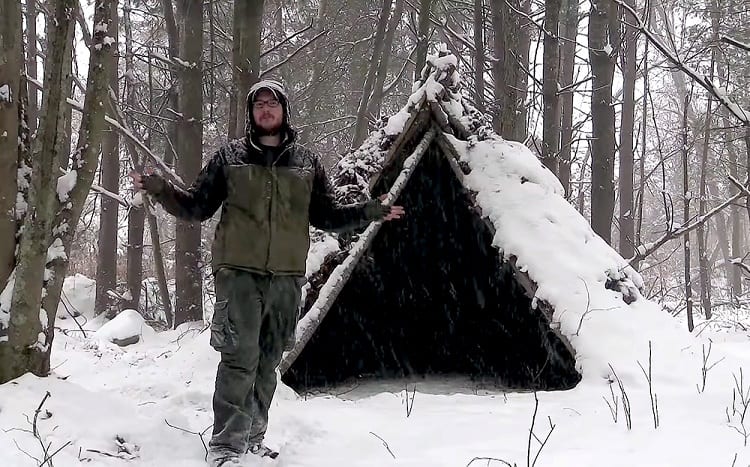
This type of shelter will provide more comfort and protection. You can quickly build a tree pit snow shelter by finding a pine tree. A pine tree will have deep pits because of its branches, so you can easily make this pit your shelter.
Cover the ground with boughs and use tree branches to hide your shelter. This elevation will create a level of insulation as well.
Quinzee
You can build a quinzee with a limited number of raw materials. Any type of snow works well if you pack it densely to make a quinzee.
You need to create a snow mound and stomp it, so your quinzee has structural integrity. After this step, start carving out the snow from the inside to create a hollow space.
Make sure to create an elevated sleeping station to avoid cold winds.
Line Shelter
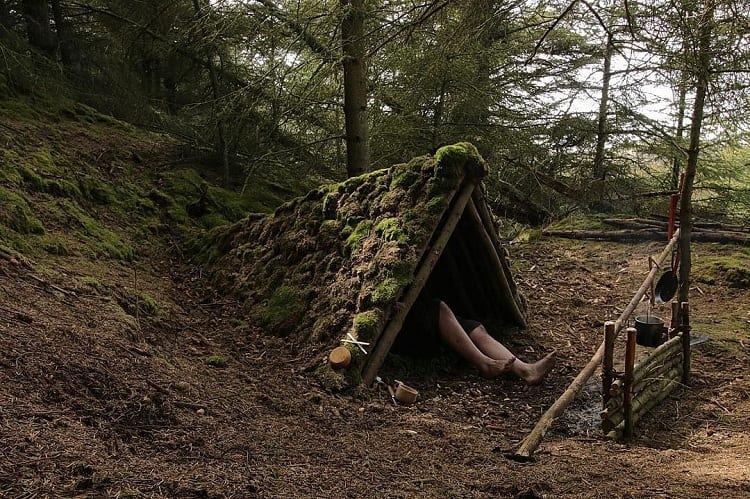
You can build this shelter with the help of one big log and few supporting logs that act as ribs. Bury one end of the big log in the ground and balance the other end by sticking two branches strategically.
It will start looking like an A. cover the rest of the body with the same technique and add one layer of tree branches and another layer of snow to keep the shelter well insulated.
Building Winter Survival Shelter: Helpful Tips To Keep In Mind
- If you plan to go away from the shelter for more than 200 yards, use a bright piece of cloth to mark your site. Snow can make it hard to find your shelter.
- Add adequate ventilation to avoid carbon monoxide poisoning.
- Avoid directly sleeping on the snow as your body can melt the snow and make your clothes wet. Staying dry should be your number one goal to avoid hypothermia. Branches covered with leaves are your best option.
- Do not sweat while building your shelter. Try to remove your clothing while building.
- Keep your bed high and the roof low.
- Always block your entryway when not in use. Dig your entrance lower than your sleeping area.
Wearing suitable clothing
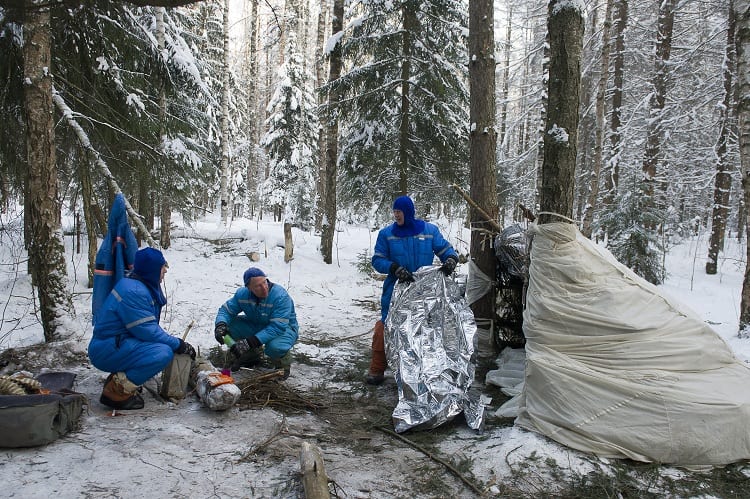
Wearing the right clothing type during your winter survival will keep you warm and safe. You cannot add random layers to keep yourself from freezing; you will need to place these layers to retain body heat strategically.
Base layer
Your clothing’s base layer is the first layer next to your skin. Your base layer should be synthetic fabrics like polypropylene or natural materials like wool.
The specialty of these fabrics is that they do not absorb sweat and wick them, which keeps your clothing dry. If the weather is freezing, we recommend covering your whole body with the base layer.
Insulating layer
This layer acts as a heat retainer to trap the body’s heat. Wool is an excellent fabric for this layer as it will give you warmth even if the material is wet.
Goose Down is your best bet for freezing weather; you can keep this as an extra clothing item because of its lightweight. Puffy jackets and fleece tops and bottoms will be a perfect choice to keep the heat trapped.
Outer layer
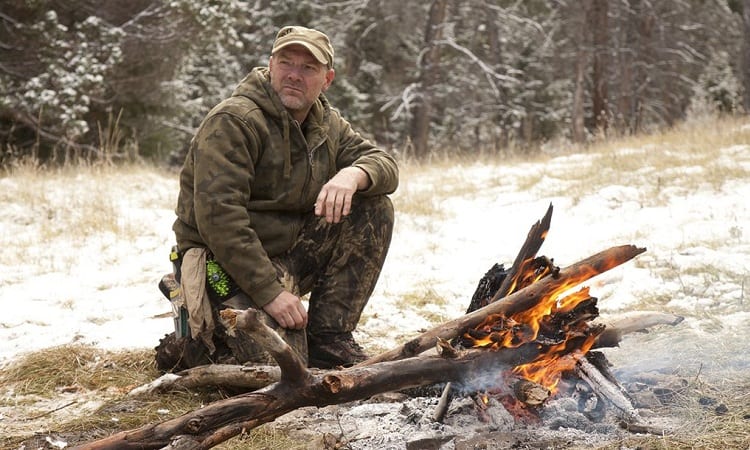
The outer layer will be your final layer which protects your body from extreme snow, wind, sleet, and cold. This layer’s clothing should be waterproof to avoid water and snow from penetrating inside the clothing layers.
Gore-Tex fabric is a new material with waterproof jackets’ properties but allows the moisture to evaporate from the body.
You can use clothes made out of this material to stay dry. Wear all your layers and then try the outer layer so see the movability and comfort of the clothing.
Avoid buying coats, pants that will make you want to remove them for easy maneuvering while working.
Extra clothing pieces to consider
Cover your head with any warm cap, preferably a wool or fleece cap. For your hands, wear fingerless gloves as your base layer and add winter mittens for proper warmth.
Leather and winter ski type gloves also come in handy during different tasks.
Make sure to size up your winter boots to give space for extra socks in case of extreme climate. Try buying wool socks to avoid getting the socks wet.
How To Starting Fire During Winter
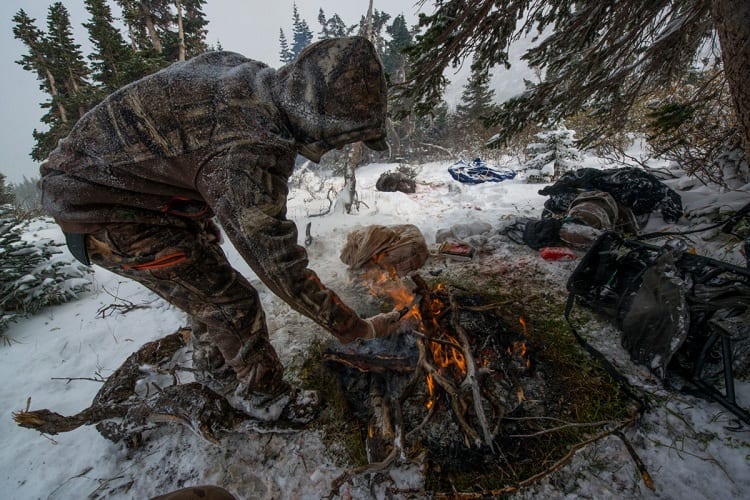
You might feel starting a fire in winter is tough, but you can quickly create a fire to keep yourself warm and comfortable with the proper knowledge.
Step 1
Find a perfect place to have a fire. Ensure the fire is not too close to your tent, shelter, and trees that can cause a fire. Clean the ground and make a center, add a lining of rocks and place your wood on top of it.
Step 2
Wood is the essential part of any fire, so choose the firewood correctly. Avoid using wood from live trees because of the moisture content. Try to gather wood that is dry and rests on a dead tree. You can very easily start a fire with dry wood.
Step 3
Choose wood from conifer species like pine, cedar, and balsam to start a fire. Wood from deciduous trees like oak, maple is perfect for keeping a fire going.
Step 4
Tinder is necessary to start the fire. You can use wood shavings, bark from a dead tree, or a forest lichen to start a fire. Clothing lint will also act as a good fire starter.
Step 5
You will need a lighter or match stick to create a flame. Ferro rod or windproof matches work the best during an extremely windy climate. Your bag will have a lighter; you can check the wind direction and use it to start the fire.
Step 6
Arrange your dead, dry branches in a teepee-shaped structure and use your tinder to start the fire. Keep adding wood as and when needed. We recommend keeping a stack of wood near your shelter for later use.
Give appropriate ventilation for the smoke if you want a fire inside your shelter.
Food And Water Consumption
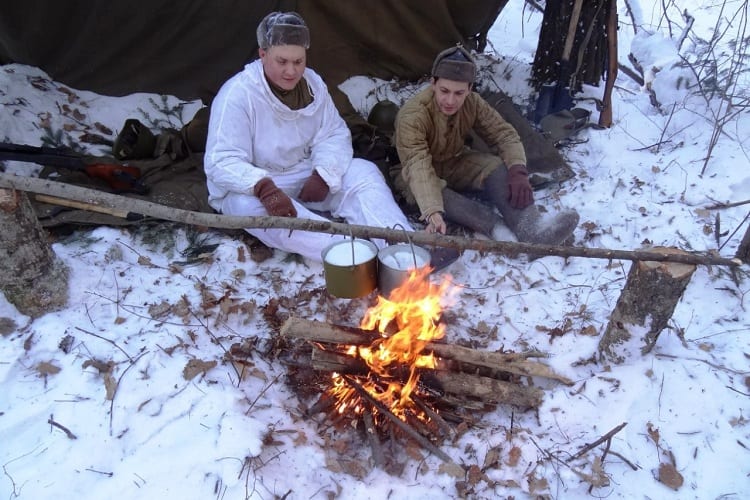
Water
- As it is winter, you will have a lot of ice to use as a water source for consumption. Always avoid eating snow directly, it will make your body temperature low, and your body will start feeling cold.
- Boil the ice and then try to drink it. If you have not built a fire yet, collect the snow in your container and keep it between your clothes’ layers. Your body heat will melt the snow.
- Keep the boiled water near so it doesn’t freeze back into ice. If you find a pine tree go ahead and add pine needles into your hot water and let it boil. Enjoy this hot refreshing tea inside your shelter for ultimate warmth.
- You can drink from a water stream around you if it hasn’t frozen yet. Make sure to strain the water to remove any dirt and debris. Boil the water for 10 minutes to purify it before drinking.
Food
- Hunting and fishing will be an excellent option to go if you want to catch a big meal that you can eat for days. Snow will make animal tracking easier. Look at their trails, droppings to understand their location. If you see a flowing stream, chances are many wildlife will come on the banks to satiate their thirst. You will have your chance to hunt them using traps or using firearms. After you have caught your prey, be quick to skin and clean the animal as the temperature will make the flesh freeze quickly. You can create an icebox and store the meat for later. Be sure to cook the meat properly to eliminate any parasites and bacteria.
- You will find wild berries and fruits according to the geographical distance. Only eat berries you are familiar with as the wrong berry can make you very sick. Mushrooms are another excellent meal option, but make sure you know about the species before eating. Mushrooms can be poisonous, so be cautious about the variety you will eat.
- Bugs and grubs will mostly stay underground or inside a rotten tree. They are excellent sources of protein. Ants, crickets, and termites are some of the common insects which are safe to eat. Make sure to boil the bugs thoroughly before eating. Stay away from bugs that are brightly colored, smell pungent, and hairy in texture.
- Acorns, chickweed, watercress, and burdock are great examples of wild plants that are edible. You can even eat cattails’ lower stalks and rhizomes for nutrition.
First Aid: Everything You Need To Know
Always pack your first aid kit according to the place and your personal needs.
You should compulsorily include personal medication, bandages, gauze, antiseptic liquid, cotton balls, MRE heat packs, aspirin, hand sanitizer, triangular sling, gloves in your first aid kit.
You can buy a store-bought first aid kit or prepare one from scratch according to your needs.
Providing First aid
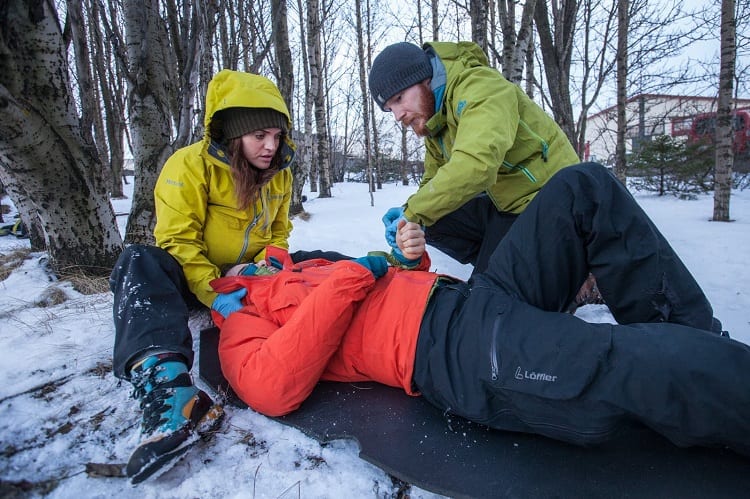
As we discussed earlier the most significant factor to consider is hypothermia and frostbite. Frostbite should be treated with extreme care as the frostbitten area is very close to tissue damage.
Do not rub the area to produce heat; it will damage the place even more. Pour warm water and keep the injury warm.
Cover the area with ample clothing to avoid freezing. To prevent hypothermia, you should keep your body healthy and blood flowing.
Cover your body as much as you can and keep drinking warm liquids. You can cure mild hypothermia by keeping the body dry and eating calorie-rich food.
Try getting help in case of serious hypothermia, as hypothermia can be extremely dangerous.
Ice can become slippery, and your chances of getting a sprain and strain increase. Use the RICE technique.
- Resting the affected area
- Applying an ice pack for relief
- Give comfortable support using padding
- Lastly, elevate the affected area
If you are unsure that the injury is a strain, sprain, or fracture, then it is advised that you treat it according to a fracture for extra safety. Your ointments and balms will be frozen, so try to keep them in a warm place.
Liquid treatment with a large percentage of alcohol will not freeze; this includes rubbing alcohol and tinctures. If you are bleeding, take a good look at the color of the blood.
Arterial bleeding will be red and purple, and you can use compression to stop it.
If the bleeding is venous, the blood will be dark and black. Get immediate help if you see this color while bleeding.
Conclusion
Winter survival is possible provided you know what you are doing and understand the situation’s seriousness. Our article on winter survival and all the vital components that will make you survive the cold, harsh wintertime.
Staying dry is the key, and keeping your body warm will keep you safe even in freezing temperatures. We hope you follow the advice to survive winter.
Resources:

